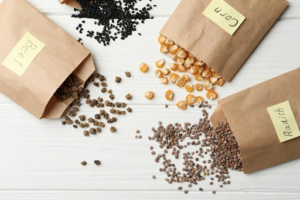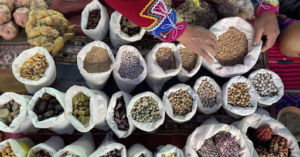Written by: Megha Rajeev
Edited by: Rayna Almas
Designed by: Eshika HIremath
Published by: Rayna Almas
Seed saving is the process of saving, storing and preserving seeds so that new crops can grow as the years go by. This is how most farmers and gardeners are able to maintain their crops throughout the years.

Why Seed Saving is Important?
Seed saving plays a pivotal role in preserving biodiversity and managing a sustainable ecosystem. Saving seeds can also result in stronger plants that are more resistant to diseases and pests as it preserves genetic biodiversity. This also means that there will be higher germination rates and bigger harvests. This is because the plants adapt to YOUR local conditions as the seasons continue. This makes your seeds more suited to your soil, climate and ecosystem rather than purchased seeds.
Seed saving is also cost efficient! Unfortunately, the prices of store bought seeds only continue to grow every year, which can only place a financial burden on many customers. Seed saving requires little effort and time and multiples your initial seed investment. This means by saving seeds, you are saving money, which reduces your gardening expenses and allows you to practice saving sustainably.
History of Seed Saving
In the earlier times, Indigenous people relied on seed saving and certain crops for different aspects. It was almost like an essential. It was beyond food production, and it played a central role in cultural and social purposes.

Many Indigenous communities have developed highly evolved systems to save seeds. They carefully choose the right time to collect, use different methods to rotate crops, and store seeds in strong containers using storage methods that can last for centuries. Their methods consider things like pollination patterns and seasonal changes. By doing this, Indigenous people protect plant diversity and make sure their crops are well-suited for their local environment. These practices help sustain farming, preserve cultural traditions and strengthen the bond between people and the land they live on.
For Indigenous communities, seed saving embodies a profound spiritual connection with Mother Earth, it is viewed as relatives, more specifically “extended family members”. It is a cultural significance, often linked to their identity, land, and heritage. Indigenous peoples have been dedicated to preserving these seeds as a way to care for and honor them for future generations. Even today, many Indigenous people keep seeds for decades and speak on the significance of saving seeds and refer to certain vegetables such as corn and beans as their ancestors.
How can you start seed saving?
The best way to start is.. by starting off with vegetable seeds!! Of course, there are specific ways to maintain your seeds based on what type of vegetable you choose, so here are some options and a small guide on how to save them!
- Peas and Beans:
These seeds go through a process of drying down, until only the pods are left. The seed pods should be left on the plant until they turn brown and dry. Harvest the pods and spread them out indoors in a cool, dry area. After a week or so, you can shell the pods to collect the seeds inside.
- Squash and Pumpkin:
These vegetables need to be perfectly ripe before harvesting them. Pumpkin and Squash seeds can be scooped out by a spoon and must be cleaned and dried properly.
- Tomatoes:
Tomatoes also need to be perfectly ripe before harvesting. However, instead of being scooped, it is recommended to be squeezed/squashed. It should be left to ferment for about 2-3 days before cleaning the seeds by removing any leftover flesh.
- Peppers:
Make sure the pepper is ripe before opening the pepper and extracting all the seeds. Clean and lay them all on a paper towel for a few days until they are dry.
Make sure that all the seeds are completely dry if you intend to store them. It is also important to label them in any container so you don’t confuse your seeds. Finish it off by leaving them in a cool, dry location away from direct sunlight until you are ready to plant them.
These vegetables are best for anyone who has just started learning about how to save seeds. It is also by far the easiest and safest option among the rest. This is because most of them are self pollinating (Tomatoes, Peppers, Beans and Peas) and require minimal effort and no special treatment before being stored. The seeds are also very easy to extract as they are fairly big.
References
IndigenousClimateHub. “Saving Seeds: Protecting the Planet and Seed Sovereignty – Indigenous Climate Hub.” Indigenous Climate Hub, 15 July 2021, indigenousclimatehub.ca/2021/07/saving-seeds-protecting-the-planet-and-seed-sovereignty/. Accessed 19 Sept. 2024.
“Mother Nature | Seed Saving: What Is It, and How Can I Do It?” Mother Nature |, 7 Apr. 2020, mother-nature.ca/seed-saving-what-is-it-and-how-can-i-do-it/#:~:text=While%20it%20may%20be%20just. Accessed 19 Sept. 2024.
November 30, and 2021 Susan Cosier. “For Thousands of Years, Indigenous Tribes Have Been Planting for the Future.” NRDC, 30 Nov. 2021, www.nrdc.org/stories/thousands-years-indigenous-tribes-have-been-planting-future.
“Saving Seeds | Basics, Benefits and beyond | Joe Gardener®.” Joe Gardener® | Organic Gardening like a Pro, joegardener.com/podcast/saving-seeds-the-basics-the-benefits-and-beyond/.
Seed Saving & Seed Sovereignty What Is Seed Saving?
“Seed Saving Part 1: The Lost Art of Seed Saving.” Garden Culture Magazine, 7 Oct. 2019, gardenculturemagazine.com/seed-saving-part-1-the-lost-art-of-seed-saving/.
“The Value and Significance of Saving Seeds and How It Benefits You.” The Permaculture Research Institute, 11 May 2015, www.permaculturenews.org/2015/05/11/the-value-and-significance-of-saving-seeds-and-how-it-benefits-you/.

